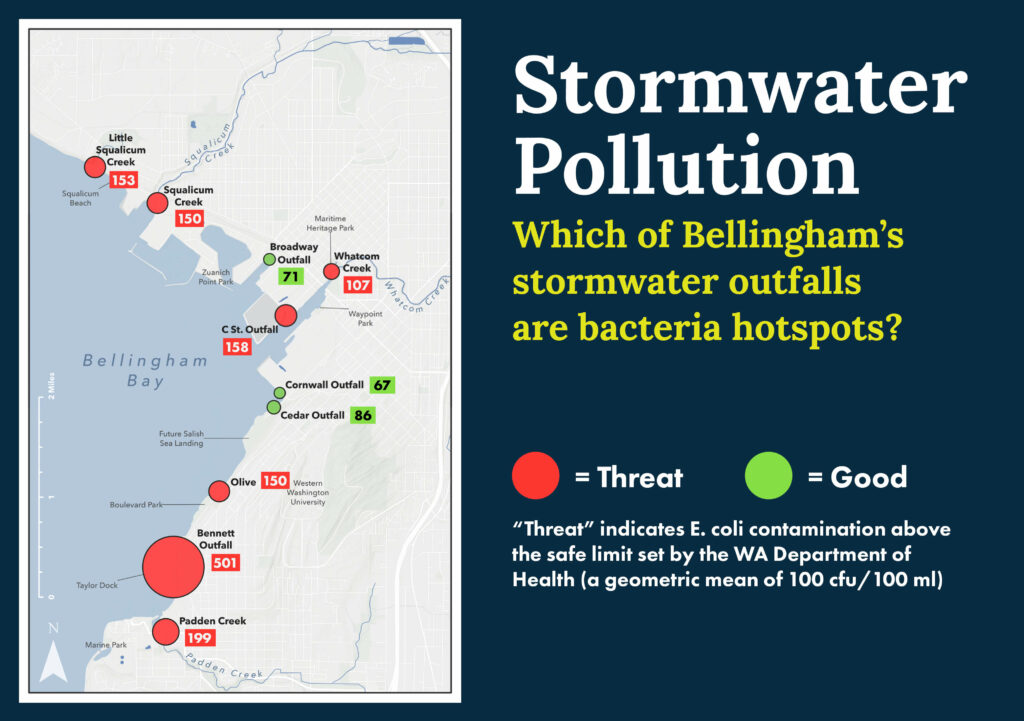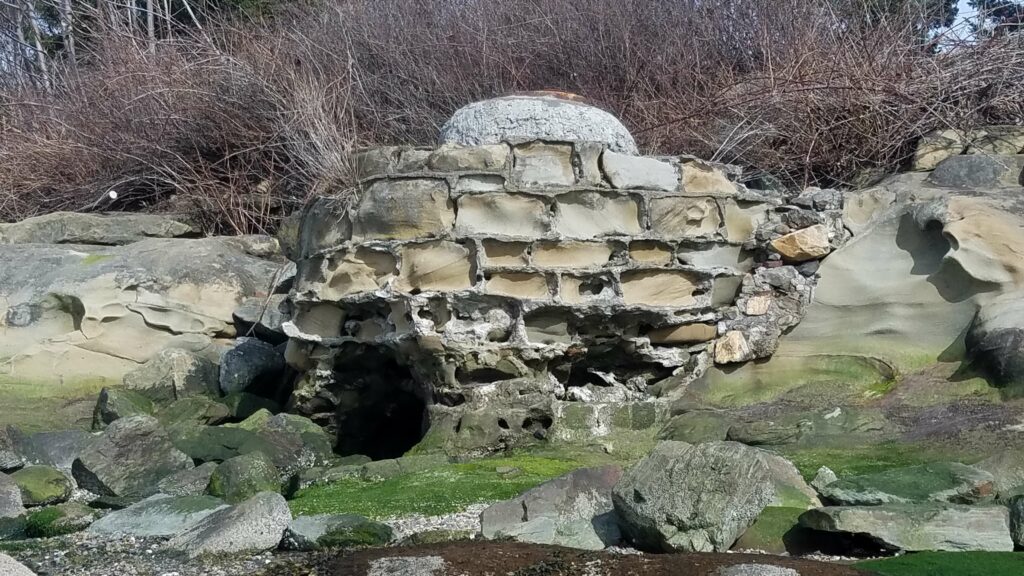RE Sources’ North Sound Waterkeeper team and our wonderful trained volunteers completed three years of monthly water quality sampling at Bellingham Bay’s stormwater outfalls and creeks. Outfalls are the endpoints of miles of roadside drains that collect the runoff from a particular area’s streets, yards and rooftops.
It’s important to remember that, unlike wastewater from sinks and toilets, stormwater is not treated. Every storm drain flows directly into Bellingham Bay. Stormwater is the Salish Sea’s leading source of pollutants, since all that wonderful rain our region gets washes every bit of brake dust, unscooped dog poop, litter and more into these outfalls. All the hard, human-made surfaces speed the flow of water (and the crud that’s built up) into storm drains, preventing natural filtration from vegetated land. A staggering 75% of toxic chemicals entering Puget Sound comes from this stormwater. For more context on our monitoring efforts, see this post.
Monitoring stormwater pollution is now a regional coalition
One big development in 2023 was that our Bellingham Bay Stormwater Monitoring program joined forces with 6 other programs to form the Salish Sea Stormwater Monitoring Program. The 6 other programs are located in: Anacortes, Oak Harbor, Everett, Mukilteo, Edmonds, and Shoreline (with the potential to expand into other regions). Procedures and methods were harmonized between the 7 programs and now all the data is stored in a collective database.

Key findings: Bacteria near Taylor Dock swimming spot, most outfalls dispensing concerning pollutant levels
Five of the 6 outfalls and 3 of the 4 creeks are rated as being a “Threat” (two more than in 2022) — this means that the water coming from these outfalls and creeks is likely contributing to an already contaminated Bellingham Bay. They frequently violate water quality standards and/or are located where people commonly spend time on the water.
One alarming finding was consistently high levels of fecal bacteria, including E. coli, at the Bennett St. Outfall, just a stone’s throw from Taylor Dock along the Boulevard Park boardwalk. The most contaminated spot is the beach between the Chrysalis Inn and the metal Grace statue. This stormwater outfall had a whopping 500 cfu/100mL* of E. coli bacteria, more than double the second most contaminated spot, Padden Creek, and five times the safe limit (100 cfu/100mL)! You can see it from the boardwalk — the outfall kind of looks like a huge, old fashioned pizza oven.

We did not test directly at the dock, and it’s likely the pollution is more diluted than our sampling site. But since this is a favorite swimming, fishing, and cold plunge spot for many in our community, we recommend caution when recreating there. If you are immunocompromised or have an open wound, swimming is less safe. If you’re healthy and just really need that swim, no one’s stopping you — but please shower off as soon as possible! If you find yourself with an infection or digestive issues after swimming in the Bay, please note it with the Whatcom County Health Department online here. This helps track health problems associated with our waterways so agencies can focus cleanup and signage efforts.
We also tested for chemicals using strip tests for 4 months. The most common chemicals found across all sampled sites were (number in parentheses indicates how many times levels were higher than safe water quality standards): sulfate (23) followed by zinc and fluoride (both 9), mercury (5), lead (4), nitrite (4), and nitrate (3).
One more excerpt from the report that’s quite telling:
“The Department of Ecology issues cities a NPDES (National Pollution Discharge Elimination System) Stormwater Permit as a means to manage stormwater pollution. Detailed Stormwater Management Manuals are provided to give permittees guidance on how to minimize and avoid stormwater pollution. These permits run on the presumptive approach that if a city follows all of the recommended and required stormwater management practices in the manual then all of the water quality standards will be met. Cities are not required to monitor their stormwater, however, so there is no way of really knowing if the stormwater is polluted. The results from Bellingham’s stormwater monitoring program, in fact, demonstrate that the stormwater being discharged into Bellingham Bay is polluted.”
*Geometric mean taken from 3 years of monthly data, 2021-2023. A geometric mean reduces extreme numbers so that a few really high bacteria counts doesn’t dictate the overall average.
You can help protect our waters
Does something seem… off about a creek, drain, lake, or shoreline? You can easily report it with a call or text the Pollution Prevention Hotline: (360) 220-0556
We also made this handy guide on how to notice pollution, when to be concerned, what’s natural, and how to report it aside from our Hotline! (Note: the Water Reporter app has sunsetted, so please utilize our Pollution Hotline or the other listed agencies if you suspect pollution)
This work would not be possible without community support. If you got something out of this information and want to help sustain our pollution prevention efforts, please consider making a one-time or monthly gift to RE Sources
Want to dig into the data and findings?
Read our complete reports:
2023 Summary Report: Year 3
2022 Summary Report: Year 2
2021 Summary Report: Year 1
This work was funded in part by a grant from Washington Sea Grant, University of Washington, pursuant to National Oceanic and Atmospheric Administration Award No. NA22OAR4170103. The views expressed herein are those of the author(s) and do not necessarily reflect the views of NOAA or any of its sub-agencies.
